- Community News
- On The Campaign Trail
- Hawaii News
- National News
- International News
- Local Sports
- Sports Spotlight
- Hawaii Sports
- National Sports
- As Maui Dines
- Bald-Headed Truth
- Letters to the Editor
- Home and Garden
- Classifieds
- Print Ad Directory
- Browse notices
- Place a notice
- Statement of Values
- Terms of Service
- Submit News

- Today's Paper

Hokule‘a marks 45th anniversary of maiden voyage to Tahiti
Crew also pays tribute to late maui navigator.

Hokule‘a sailed into Honolua Bay and past the family home of late pwo navigator Chad Kalepa Baybayan on Saturday. The canoe also sailed by Kalaupapa on the way back to Oahu. JAKE MAROTE/OLUKAI photos
The Maui News
Forty-five years after Hokule’a departed Honolua Bay on her maiden voyage to Tahiti, the legendary voyaging canoe returned to Maui on Saturday to mark the historic anniversary.
May 1, 1976, was the first time in more than 600 years that a Polynesian voyaging canoe sailed down Kealaikahiki, the ancestral sea road connecting Hawaii and Tahiti, using traditional navigation, according to the Polynesian Voyaging Society.
Hokule’a and sister canoe Hikianalia sailed from Oahu and arrived at Honolua Bay on Saturday morning to remember and honor the voyaging visionaries, Micronesian navigator Mau Piailug and the 1976 crew members whose daring voyage helped reawaken a lost tradition and restored pride and dignity to Native Hawaiians, the voyaging society said.
The crew also sailed past the Lahaina family home of the late pwo navigator Chad Kalepa Baybayan, who as a young man in 1976 quietly helped paddle crew members from the shore of Honolua Bay to Hokule’a for departure. Baybayan, who dedicated his life to voyaging, navigation and Hawaiian culture and language, passed away in April at the age of 64.

Voyaging canoes Hokule‘a and Hikianalia sail into Honolua Bay on Saturday to mark 45 years since Hokule‘a first departed Honolua Bay for her maiden voyage to Tahiti.
The Hokule’a crew members on the 1976 voyage from Hawaii to Tahiti included Clifford Ah Mow, Shorty Bertelmann, Ben Finney, Tommy Holmes, Sam Kalalau, Boogie Kalama, Kawika Kapahulehua, Buffalo Keaulana, John Kruse, Dukie Kuahulu, David Lewis, Dave Lyman, Billy Richards, Rodo Williams and Piailug, who used the wind, waves, stars, birds and clouds to find their way to Tahiti, despite never having sailed the Southern Hemisphere.
National Geographic photograph Nicholas DeVore and filmmaker Dale Bell were also on board.
Four of the original crew members — Bertelmann, Keaulana, Kruse and Richards — as well as Bell, are still living.
The voyage to Honolua Bay on Saturday not only marked a historic anniversary but was also part of a series of training sails to help prepare the crew for the 41,000-mile, 42-month circumnavigation of the Pacific that will cover 46 countries and archipelagos, nearly 100 indigenous territories and 345 ports. The goal of the Moananuiakea Voyage is to develop young crew members, navigators and leaders for the planet, the voyaging society said.
“A year from today, May 1, 2022, we will launch the Moananuiakea Voyage and in five years from today we will return here to Honolua Bay to mark 50 years of Hokule’a and voyaging,” said Nainoa Thompson, president of the Polynesian Voyaging Society. “We believe the world needs navigators, and we are laying down that challenge now, that in five years when we return to Honolua Bay, we will have inspired and elevated 10 million navigators and young leaders of all kinds to lead our earth into a sustainable, thriving future.”
On the way back to Honolulu, Hokule’a and Hikianalia also sailed by Kalaupapa to remember, pay respect and aloha the community that welcomed the crew that brought Hokule’a home from Tahiti in 1976. Thompson said the crew was told to hold off and not return to Oahu yet while celebratory preparations were underway, so they decided to wait off of Kalaupapa for safe anchorage, away from big crowds.
“The crew didn’t go ashore, but the Kalaupapa patients crowded into a row boat with their ukulele and went out to Hokule’a, climbed on board and they were joyously singing in the canoe,” Thompson recalled.

Today's breaking news and more in your inbox
- Daily Newsletter
- Breaking News
KCC Kahului closed for painting May 9, 10
The main parking lot gates near the tennis courts and soccer field complex at Kahului Community Center will be ...
Ti leaf lei making for Memorial Day, May 16
Ti leaf lei making for Memorial Day will be the featured event at the Kaunoa Clubhouse in the Royal Lahaina ...
MFD battles 30-acre brush fire Sunday night
Maui Fire Department crews arrived off Maui Veteran’s Highway at approximately mm5, to find multiple areas of ...
Disaster recovery meeting encouraged
Residents are encouraged to attend the Weekly Disaster Recovery Community Update Meeting at 5:30 p.m. Wednesday, ...
Akaku Upstairs – The Green Wave: Maui
Akakū Upstairs returns on Thursday May 16, with a screening and discussion of the short film, The Green Wave: ...
Woman charged for alleged theft of more than $44,000 in union dues
The Maui News HONOLULU—Hawaii Attorney General Anne Lopez announced today that Lilinoe Smith has been ...
Only $99/year
Subscribe today.
Off the charts: how a Polynesian canoe inspired a renaissance in traditional seafaring
The Hōkūleʻa’s oceanic voyages, navigated by the stars, have led other Indigenous people to revive their own ancient traditions – and serve as a call to action on the climate
A double-hulled Polynesian sailing canoe glides up to a busy dock in San Diego , California. Hōkūleʻa’s two short wooden masts are dwarfed by the historic schooner that escorted the boat into the harbour. Dozens of small outrigger canoes trail in its wake, honouring the crew’s arrival.
Once the docklines are secure, Hōkūleʻa’s 13 crew members put on ceremonial leis – floral garlands – and request permission from the local Indigenous tribe to come ashore. In response, 30 members of the Kumeyaay Nation sing and dance to welcome them to their native lands. Hundreds of onlookers snap photos before joining the festivities at a nearby park.
The celebration in San Diego is partly to honour Hōkūleʻa’s 2,800-mile voyage down the west coast of North America with no compass, charts or GPS (not to mention no galley or toilet).
It is also about honouring this small craft’s leading role in inspiring a cultural renaissance in traditional sailing that has rippled well beyond the Hawaiian shores where it was launched 49 years ago.
“The fact that it’s possible to conduct navigation across thousands of miles of open ocean without instruments is inspirational for all of us,” says Ray Ashley, director of the Maritime Museum of San Diego, where Hōkūleʻa docked.
“The ability to solve problems in ways that rely on logic and intelligence and courage and all the things this canoe [crew] embodies is something that’s sorely needed now, which is why this vessel and the voyage she’s embarked on are crucially important.”
Last June, Hōkūleʻa left the Alaskan port of Juneau on the Moananuiākea voyage, a four-year circumnavigation of the Pacific Ocean. So far, it has visited 35 communities and had nine crew changes. It still has 37,000 miles (60,000km) and three years to go before the voyage is complete.
“We’re trying to learn as much as we can about who we are and who our ancestors were, and looking for the balance between science and Indigenous cultures,” says Bruce Blankenfeld, voyaging director of the Polynesian Voyaging Society (PVS) and a master navigator who has sailed all over the world onboard Hōkūleʻa.
Standing on the boat’s deck with the lights of San Diego behind him, Blankenfeld adds that practising and teaching traditional navigation “is how we keep validating it as a living culture”.
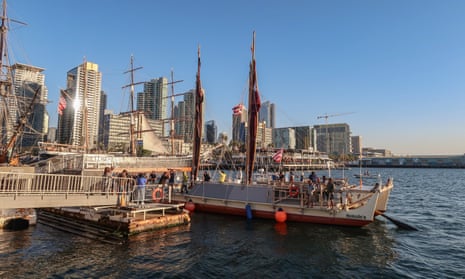
At the helm, manoeuvring Hōkūleʻa’s long wooden steering oar, is the captain, Tamiko Fernelius. “This canoe connects people from all different countries and islands,” she says.
Fernelius, 45, has worked on ships most of her adult life and began learning traditional navigation 14 years ago. “Navigation is observing nature and paying attention to your surroundings and yourself. The more you understand and make sense of these things, the more you will respect them and want to take care of them,” she says.
First launched in O‘ahu in 1975, Hōkūleʻa means “star of gladness” – the Hawaiian name for the zenith star used in celestial navigation , better known as Arcturus, which appears directly over Hawaii. PVS constructed the replica of an ocean-voyaging canoe to disprove the theory that ancient Polynesians drifted across the Pacific instead of purposefully navigating to their desired destinations.
This idea had been popularised by the Norwegian explorer Thor Heyerdahl , who crossed the ocean on a balsa-wood raft named the Kon-Tiki in the late 1940s in support of his notion that the inhabitants of the Polynesian Islands originally came from South America.
Archaeological evidence suggests that Polynesian voyagers can be traced back to the Indigenous people of Taiwan between 3,500 and 5,000 years ago. But until Hōkūleʻa demonstrated otherwise, many western historians and anthropologists believed that Pacific islands were populated by “people drifting downwind on rafts from South America, or fishermen being blown out to sea, or people just accidentally running into islands”, Ashley says.
In 1976, PVS asked Mau Piailug, a master navigator from Satawal in Micronesia, to guide Hōkūleʻa on a 2,400-mile test voyage from Hawaii to Tahiti without modern instruments. When they successfully arrived in Papeete a month later, more than half the island’s population came out to greet them.
“We tend to think of great cultural achievements in terms of paintings or works of literature or buildings like pyramids or temples. But I think all of those things pale in comparison to what was accomplished more than 1,000 years ago by Polynesians,” says Ashley.
Wayfinding is an ancient and highly complex skill. For instance, for Hōkūleʻa’s ocean voyages to Tahiti, the canoe’s navigator must memorise the relative positions of about 200 different stars and watch where they rise and set to ensure the boat arrives safely at a small island in a vast sea.
But when it is cloudy at night, wayfinders must find their position and direction of travel using other clues, such as the direction of the waves or the flight path of certain birds.
While Polynesians travelled further than most early explorers, they are not the only example of cultures that used impressive methods to navigate. For instance, the Inuit of Greenland carved driftwood in the shape of coastlines to create tactile maps for their journeys over Arctic ice. In Siberia, the Evenki use rivers as landmarks when hunting reindeer. The Pitjantjatjara in Australia use the smell of plants and seasonal changes to identify their routes.
after newsletter promotion
The revival of wayfinding in Hawaii is “delightful”, says Hugo Spiers, a professor of cognitive neuroscience at University College London, who has researched traditional methods of navigation .
However, he also emphasises that a few pockets in the Pacific never lost “their original, traditional knowledge that has been maintained and passed on”, such as on Taumako, in the Solomon Islands, and the atoll of Satawal in Micronesia.
“As society has gone on, we’ve mostly lost that connection to the natural landscape,” says Spiers. He believes that traditional navigation fosters an appreciation of the landscape, including the need to stem habitat loss and the climate crisis. “It’s a real mistake if we jettison some of these powerful methods developed in the past,” he says. “We will regret it.”
The first voyages on Hōkūleʻa sparked a renaissance of many Hawaiian traditions that had disappeared after Europeans colonised the islands. Today, Hawaiian children learn the native language in school, along with hula dances , traditional chants and celestial navigation.

Having covered more than 140,000 miles, Hōkūleʻa has inspired other revivals of seafaring traditions around the world. Indigenous communities in Aotearoa (the Māori name for New Zealand), Tonga, Samoa, Tahiti and the Cook Islands have all built their own voyaging canoes and sail them using traditional navigation techniques.
Yarrow Vaara, a member of the Tlingit clan in south-east Alaska , saw how the Hawaiians were building voyaging canoes and co-founded the One People Canoe Society in Juneau to “bring back the tradition of using our waterways as a mode of transportation for our communities”. When Hōkūleʻa last visited San Diego in 1995, it inspired the local Chamorro community (a group indigenous to the Mariana Islands) to build their own outrigger canoe.
One of the ways the Hawaiians have so successfully revitalised their voyaging traditions is by fostering a community where everyone is welcome onboard – regardless of ethnicity, age or gender – as long as they are willing to share in the work.
Fernelius is a perfect example: born in Okinawa, Japan, she moved to Hawaii in 2009 and began volunteering for PVS to learn about wayfinding. She has always felt welcome.
“Everybody has a different background but once you come on deck, you’re ‘ohana , you’re family,” Fernelius says.
But this inclusive atmosphere was not part of traditional Polynesian sailing customs. In most Polynesian cultures “women couldn’t even touch the shadow of the canoe”, much less sail, captain or navigate the boats, says Nainoa Thompson, master navigator and president of PVS. But PVS has changed that because “in our world, equality matters”.
About a third of the crew on the Moananuiākea voyage are in their early 20s. Most learned traditional sailing and navigation at Hawaii’s private Kamehameha high schools, which teach children of Native Hawaiian ancestry in traditional culture and practices.
Today, some children on the islands are learning these skills even earlier. “Little preschoolers are chanting the star compass faster than I could,” says Jonah Apo, 23, a watch captain and protocol officer onboard Hōkūleʻa .
Apo believes that the Moananuiākea voyage will serve as a call to action for more people of all ages to help heal the oceans and the wider environment. This is especially relevant with the effects of the climate emergency.
“Record-breaking temperatures, an increase of storms – it makes our ability to voyage a lot riskier. It has changed sail plans for this voyage and raises the alarm even more that change needs to happen.”
- Seascape: the state of our oceans
- Indigenous peoples
- Pacific islands
- Asia Pacific
- South Pacific
Most viewed
Hōkūle‘a World Wide Voyage: An Ending, A Beginning . . .
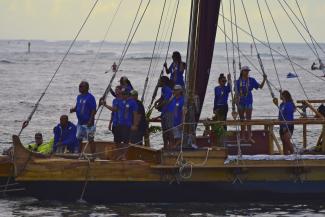
Kaimana Barcarse
This article is the sixth installment in a series documenting the historic undertaking of the three-year voyage of Hōkūle‘a, a full-scale replica of a wa‘a kaulua (Polynesian double hulled voyaging canoe) around the world. As the first of the fleet of canoes escorting Hōkūle‘a enters the channel to Magic Island, many remember when Hōkūle‘a first left Honolulu on its first international leg of the World Wide Voyage in May 2014. A crowd in the tens of thousands, growing to an estimated 50,000 by the end of the day, have converged on Magic Island to witness this auspicious event.
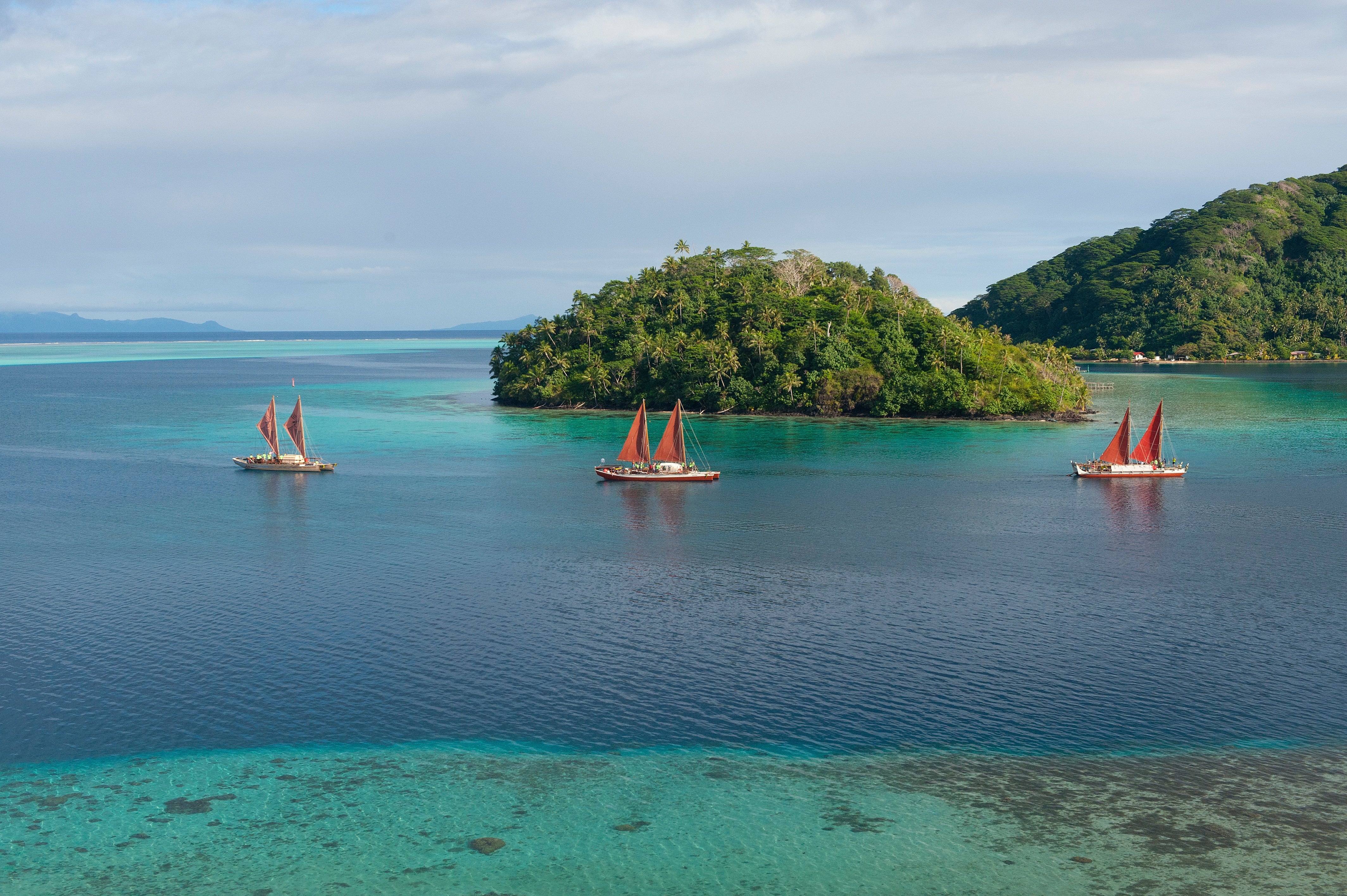
When we got back to Hawai‘i a few months later, the leadership of the ‘Ohana Wa‘a (Family of the canoes) met at Nā Kālai Wa‘a‘s Hō‘ea site in Kohala, Hawai’i island, and Nainoa Thompson, head of the Polynesian Voyaging Society, laid out the first sail plan for the World Wide Voyage and elicited the support of the ‘Ohana Wa‘a to sail around the world with the idea of sharing Indigenous knowledge and wisdom from here in Hawai‘i in order to bring awareness of our planet, our “Island Earth,” of which we all have a stake in. And thus, a voyage was born. But this was no ordinary voyage. It would take the next six years to properly research the route, rebuild the canoe, conduct sea trials, and train the huge crew that it would take to pull this voyage off. Thousands of volunteers came forth to put their mana (spirit and power) towards preparing Hōkūle‘a for this next large chapter of her life. This meant dismantling her down to bare hulls, and building her back up to be able to handle sea conditions in unfamiliar oceans, conditions unlike those through which we have been sailing over the last 38 years. Of these volunteers, a few hundred rose to the challenge to complete the rigorous training required to become a crew member on the voyage. This involved physical conditioning with a test that included physical exertion exercises, a timed mile run, and a timed mile swim. It also involved mastering basic seamanship skills, first aid skills, ocean survival skills, specialized Polynesian voyaging skills, a basic understanding of traditional Hawaiian non-instrument navigation, and mastery of at least one other specialized skill. On the voyage, each crew member is responsible for at least one specialized assignment, along with pitching in on other roles from steering, to cooking, to fishing, to repairs and maintenance. I had the privilege of serving as protocol officer, education specialist, and navigator, although like every single one of my crewmates, we pitched in and did every job on the canoe that needed to be done.
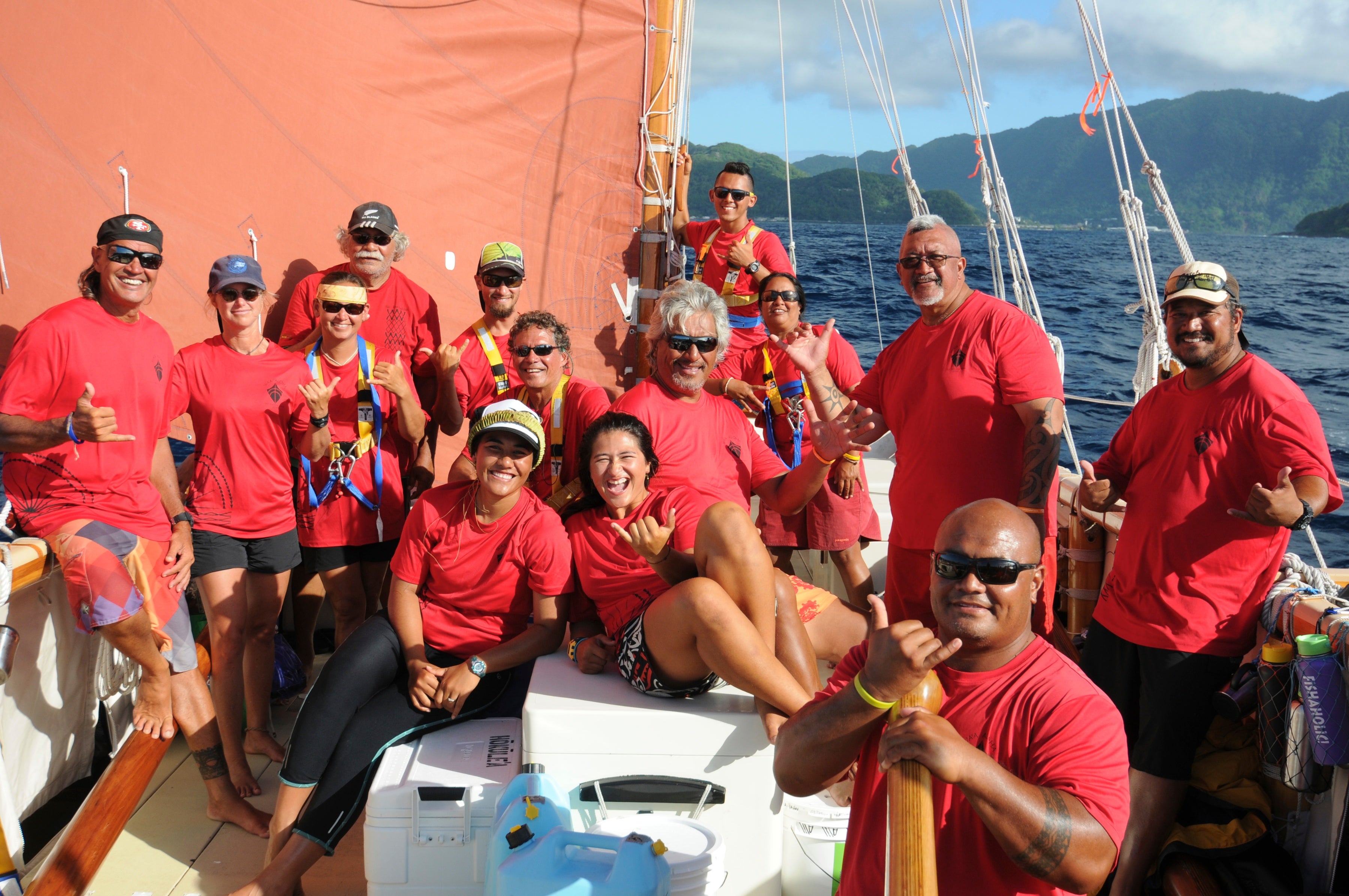
Photo by Kamakanioka‘a–ina Paikai. Once the dry dock was finished and the newly reconfigured Hōkūle‘a was launched, it was time for sea trials and crew shakedown. A brief set of sea trials were conducted, and we made ready for the Mālama Hawai‘i voyage (caring for Hawai‘i). This was a voyage throughout the island chain, visiting numerous communities on each island and crossing every channel in Hawai‘i, which would serve as the final real life sea trial and crew readiness test before leaving Hawaiian waters. This inter-island voyage was not intended as a sea trial, but more so to visit each island and gather the aloha and mana of our people in order to take that with us as we traveled around the world. At the conclusion of the Mālama Hawai‘i statewide voyage, Hōkūle‘a returned to O‘ahu for a final provisioning before setting sail on its first international leg. Next stop, Tahiti. As we circumnavigated the world over the last three years from May 2014 through June 2017, we traveled 42,000 nautical miles, stopped at over 150 ports in more than 23 countries and territories, and visited eight of UNESCO’s Marine World Heritage sites. When we left Hawai‘i in May, we headed to Tahiti where we stopped at all of the major French Polynesian islands, with special visits to Taputapuātea on the island of Raiatea, and a first time landing on the island of Maupiti, before continuing on to the Cook Islands with stops at Rarotonga and Aitutaki. After leaving the Cook Islands we made our way to Samoa, first paying homage to the chiefly Manu‘a islands before stopping in American Samoa, then continuing on to Western Samoa. From Western Samoa we continued south to Tonga, then on to Aotearoa, the land of the long white cloud. After a dry dock in Aotearoa, we crossed the Tasman Sea, our first time outside of the Pacific proper, arriving in Southeastern Australia and making our way north along the Northeast coast until leaving the continent for Bali, Indonesia. From Bali, we made our way west-southwest to Mauritius in the Indian Ocean, then rounded the southern tip of Madagascar, where we intended to make port, but were waved off in anticipation of an impending storm.
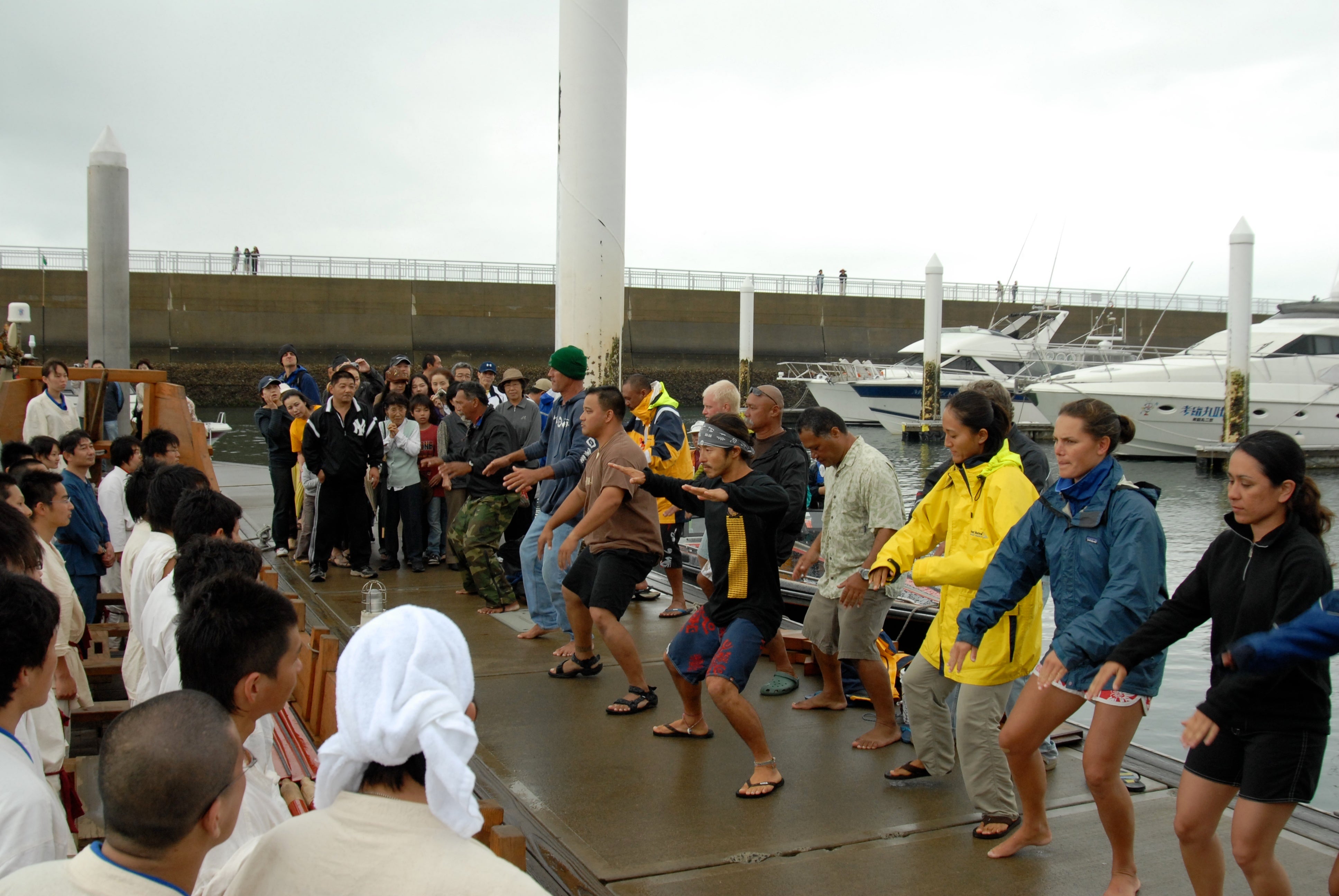
I am brought back from my reflections as the pū (conch shell) blows once again, signaling the arrival of another canoe into the channel. The first canoe to arrive was the 70-foot Nāmāhoe of Kaua‘i, the largest Hawaiian made canoe in our fleet, and the most recently launched. Following Nāmāhoe was Mo‘okiha-o-Pi‘ilani of Maui, then Makali‘i of Kawaihae-Hawai‘i Island. The next canoe in was Hawai‘iloa, the canoe made from the spruce logs gifted to us by the Tlingit Haida tribes of Alaska so that we could carve a traditional canoe from single logs, as was custom in times gone past. Next in was Okeanos Marshall Islands, a short, single mast voyaging canoe perfect for interisland commuting and transport. Okeanos will be making its way to the Marshall Islands after the homecoming where she will gain a new home port. After Okeanos, our next visiting canoe arrived, Faafaite of Tahiti. Faafaite accompanied Hōkūle‘a and Hikianalia on Leg 2 of the World Wide Voyage from Tautira throughout French Polynesia and onto Rarotonga before returning to her homeport of Tahiti.
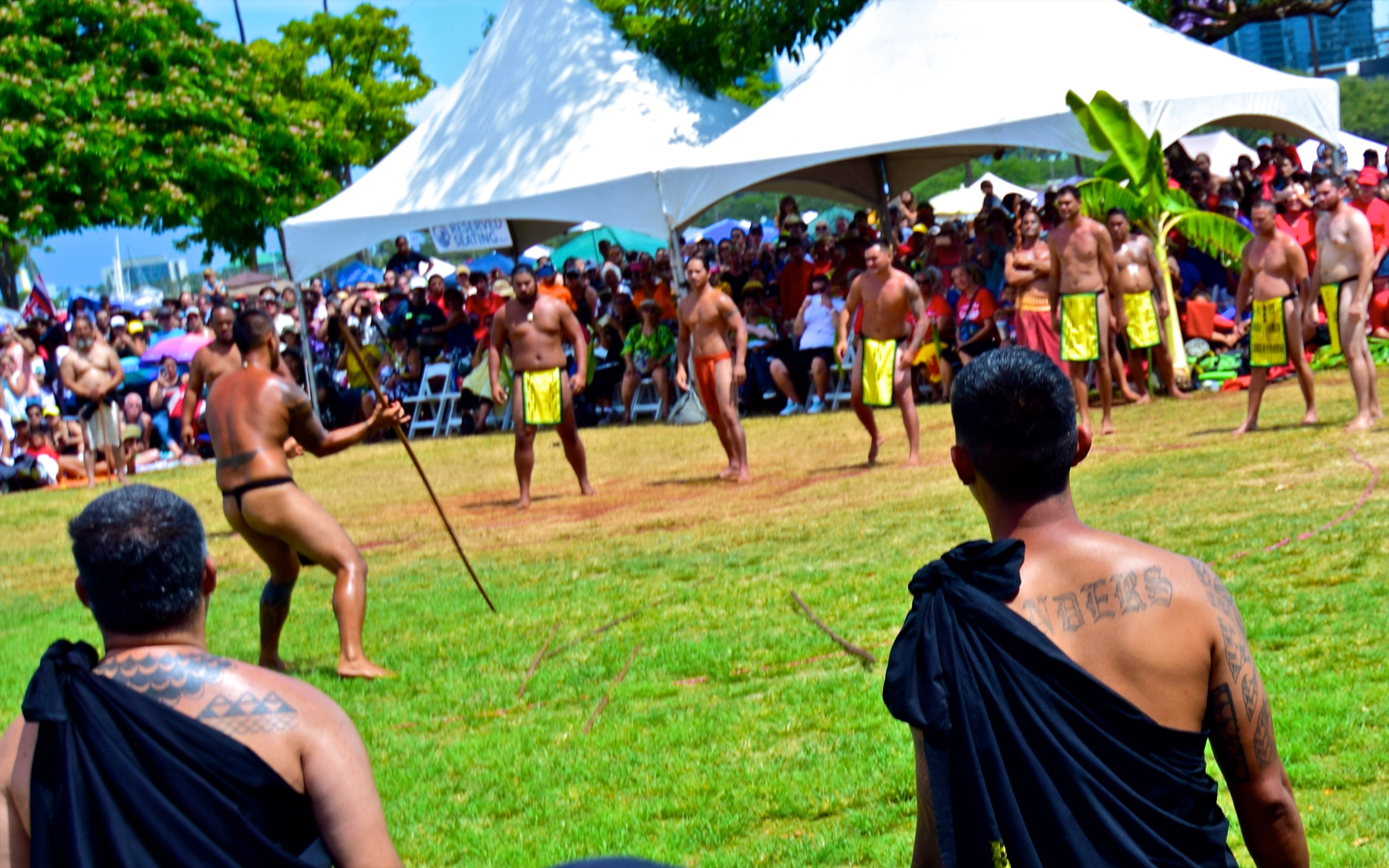
—Kaimana Barcarse is the West Hawai‘i regional director for Kamehameha Schools, and the program director and lead DJ of Alana I Kai Hikina on KWXX-FM. Barcarse also serves on the board of directors at Cultural Survival and chairs the board of The Cultural Conservancy.
Visit www.cs.org for the original Hawaiian language version of this story. Visit goo.gl/Hjxa2p for previous articles documenting the World Wide Voyage.
Photos by Kaimana Barcase.
Our website houses close to five decades of content and publishing. Any content older than 10 years is archival and Cultural Survival does not necessarily agree with the content and word choice today.

Land Acknowledgement We acknowledge that we are headquartered on Massachusett land , in Cambridge, MA, and we thank the past, current, and future Indigenous stewards of this territory.
Our Mission
Cultural Survival advocates for Indigenous Peoples' rights and supports Indigenous communities’ self-determination, cultures and political resilience, since 1972.
Cultural Survival envisions a future that respects and honors Indigenous Peoples' inherent rights and dynamic cultures, deeply and richly interwoven in lands, languages, spiritual traditions, and artistic expression, rooted in self-determination and self-governance.
Stay Informed
Sign up today to stay informed about the latest news, Cultural Survival program updates, events and MORE...
- Cultural Survival E-Newsletter - News and Updates
- Bazaars and Events
- Information on conferences, meetings and global events pertaining to Indigenous Peoples
- Free digital CSQ Magazine
© 2023 Cultural Survival. All Rights Reserved. | Donor Privacy Policy | EIN: 23-7182593
The voyaging canoe was built in order to challenge the notion that Polynesians had discovered and settled the Pacific islands by accident. By building a replica of an ancient voyaging canoe and navigating it from Hawai'i to Tahiti and back without instrument in 1976, PVS showed how it would have been posssible for ancient Polynesians to sail and explore the Pacific ocean and settle its islands purposely, as a way of finding new homelands scattered over an oceanic area of ten million square miles, geographically the largest "nation" on earth--larger than Russia. (For a scholarly article on the founding of Polynesian Voyaging Society and the building of Hokule'a, see “ The Founding of the Polynesian Voyaging Society ” by one of the co-founders, Ben Finney.)
Herb Kawainui K a ne, another co-founder of PVS, came up with the conceptual design for the canoe, with Kenneth Emory. (For details on how H o k u le‘a was designed, see K a ne’s “ In Search of the Ancient Polynesian Voyaging Canoe ”). The canoe is maintained by hundreds of volunteers, with drydocking before each long voyage.
It has two 62-foot hulls; eight `iako, or crossbeams, joining the two hulls; pola, or decking, lashing to the crossbeams between the two hulls; rails along the decking; and two masts.
Illustrations :
Large Color Drawing of H o k u le‘a by Honolulu Star-Bulletin Artist David Swann (Appeared June 7, 1999). Large Color Drawing of H o k u le‘a with New Sails by Honolulu Advertiser Artist Greg Taylor (Appeared June 6, 1999). Construction Drawings for H o k u le‘a Black and White Diagram of H o k u le‘a, with Names of Each Part.
How the Canoe was Named : "This happened when the parts of the canoe were close to being completed. One day when I visited the building site, a large shed at Young Bros., one of the guys had chalked 'Da Boat' on the side of one of the hulls. When I asked the reason for the graffiti, they said it was to remind me that it was time to come up with a name.
"According to Kenneth Emory, in the old days a name would come to a canoe designer in a dream. Be that as it may, we tossed the question around at the board meeting a few days later. Several names were suggested, mostly compound names, each including several words; none seemed to be what everyone was looking for. Several weeks went by.
"One exceptionally clear night I stayed up quite late, star chart in hand, locating and memorizing stars and their relative positions. I think I turned in around midnight. Some time later, I dreamed of stars. My attention was attracted to Arcturus, our Hokule'a. It appeared to grow larger and brighter, so brilliant that I awoke.
"It's been a habit for many years to keep a pad and pen on my nightstand. When the body is at rest, the mind half-awake, thoughts range about freely, and ideas form which I've found are sometimes worth noting down. Some painting ideas have come to me that way. I turned on my reading light and wrote 'Hokule'a.'
"The next morning, I saw the notation, and immediately recognized it as a fitting name for the canoe. As a zenith star for Hawai'i it would be a star of gladness if it led to landfall. I phoned Paige Kawelo Barber; she thought it appropriate. I tried it on a few others and got a positive response. The name was proposed at the next board meeting and adopted." (e-mail from Herb, 2/20/99).
Hokule`a was launched on March 8, 1975 at Kualoa on the windward side of O`ahu. Ka`upena Wong organized the religious ceremonies for the launching, with Kalena Silva and Keli`i Tau`a assisting in the rituals. Kahu Kaupu gave the Chrisitan blessing. Hokule`a made its first voyage to and from Tahiti in 1976.
The 8-ton Hokule`a can be loaded with about 11,000 pounds, or 5.5 tons, including the weight of a crew of 12-16 people and equipment and supplies. It can make up to 10-12 knots sailing on a reach in strong winds.
Since Hawaiians had ceased long-distance, open-ocean voyaging eight centuries ago in the 12th century, no examples of actual ancient voyaging canoes were available as models for Hokule`a. Hawaiian artist Herb Kane based the design of Hokule`a on drawings of canoes made by artists and draftsmen employed by Captain Cook and other early explorers of the Pacific.
How close to an ancient voyaging canoe is Hokule`a? Hokule`a is considerably smaller than the 100-foot plus Polynesian canoes seen by early European visitors. Also, while the design of the hulls and upper parts of the canoe was based on what is known of the traditional Polynesian canoe, the design of the sail-rig departed from traditional precedents. The traditional Polynesian sprit sail was typically laced to two spars, one of which acted as the mast and the other as the boom. The rig Hokule`a consists of a sail attached to spar and boom plus a shorter mast on which the spar, boom and sail are raised and lowered. Hokule`a's rig, with the mast first raised and stayed, was used to facilitate the raising and lowering of the sail.
Because of the use of modern materials, sailing the canoe could not tell PVS about the strength and durability of traditional canoes. However, the builders strove to approximate the shape and weight of a traditional canoe, avoiding such innovations as wider stance for the hulls for greater stability and a deeper keel for improved sailing capability; so the canoe was a "performance accurate" replica, handling much like the voyaging canoes that once sailed in Polynesian seas.
[Sources: Ben Finney's "Voyaging into Polynesia's Past" in From Sea to Space , Palmerston North, New Zealand: Massey Press 1992 and Voyage of Rediscovery , Berkeley: University of California Press, 1994; Notes from Herb Kawainui Kane on the early history of H o k u le'a; also, David Lewis` The Voyaging Stars: Secrets of the Pacific Island Navigators , New York: W.W. Norton, 1978.]
Smithsonian Ocean
Hōkūleʻa is welcomed in tahiti in 1976.

The arrival of Hōkūleʻa in Tahiti 1976. More than 17,000 people attended to celebrate this historic landing within the canoe's first long voyage, from Hawai`i to Tahiti and back.
- Make Way for Whales
- Sharks & Rays
- Invertebrates
- Plants & Algae
- Coral Reefs
- Coasts & Shallow Water
- Census of Marine Life
- Tides & Currents
- Waves, Storms & Tsunamis
- The Seafloor
- Temperature & Chemistry
- Ancient Seas
- Extinctions
- The Anthropocene
- Habitat Destruction
- Invasive Species
- Acidification
- Climate Change
- Gulf Oil Spill
- Solutions & Success Stories
- Get Involved
- Books, Film & The Arts
- Exploration
- History & Cultures
- At The Museum
Search Smithsonian Ocean
Click here for a visual timeline of Hōkūleʻa’s history.
On March 8, 1975, Hōkūle‘a, a performance-accurate deep sea voyaging canoe built in the tradition of ancient Hawaiian wa‘a kaulua (double-hulled voyaging canoe), was launched from the sacred shores of Hakipu‘u-Kualoa, in Kāne‘ohe Bay on the island of O‘ahu. She was designed by artist and historian Herb Kawainui Kāne, one of the founders of the Polynesian Voyaging Society. The canoe was named Hōkūle‘a (“Star of Gladness”), a zenith star of Hawai‘i, which appeared to him growing ever brighter in a dream. This launching was one of many events that marked a generation of renewal for Hawai‘i’s indigenous people. Along with the renewal of voyaging and navigation traditions came a renewal of Hawaiian language, dance, chant, and many other expressions of Hawaiian culture. The renewal represented a new-found respect and appreciation for Hawaiian culture, by all of Hawai’i’s people.For the Hawaiian people, it has meant that they once again have begun to feel proud of who they are, and where they come from.
During that generation of voyaging (1975-2000), Hōkūle‘a sailed on six major voyages from Hawai‘i, at the apex of the Polynesian triangle, to Aotearoa (New Zealand) at the southwestern corner, and finally to Rapa Nui, at the southeastern corner. Her voyages inspired a revival of canoe building and voyaging throughout Polynesia.

To view or download hi-res diagram of Hōkūleʻa click here.
Hōkūleʻa at a Glance:
- Built in Honolulu, Hawaiʻi and launched on March 8, 1975
- Has sailed over 140,000 nautical miles across the Pacific
- Length: 62 feet
- Width: 20 feet
- Hōkūleʻa is the Hawaiian name for the star Arcturus
National Geographic content straight to your inbox—sign up for our popular newsletters here

This legendary Polynesian canoe will sail 43,000 miles, from Alaska to Tahiti
The crew of the Hōkūleʻa is embarking on an arduous 47-month journey across the Pacific Rim.
The feat of Polynesian wayfinding—navigating by stars, wind, and waves—had long been discounted by scholars on the grounds that ancient Polynesians didn’t have the knowledge to be master navigators. But in 1976, a traditional 62-foot, double-hull voyaging canoe called Hōkūleʻa sailed from Hawaii to Tahiti with a crew of 15, proving that the old ways were more than enough to carry people across the vast ocean.
Now, the next generation of Polynesian wayfarers is stepping up and getting onboard. Beginning June 15 in Alaska, Hōkūleʻa and her sister canoe Hikianalia will set off on a 43,000-nautical-mile, 47-month circumnavigation of the Pacific Ocean. The journey will take them to 36 countries and archipelagoes, nearly a hundred Indigenous territories, and 345 ports. There’ll be about 12 crew on each canoe at a time, switching out about every four weeks, for a total of 400 crew members over four years.
Here’s what to know about this epic voyage.
Hōkūleʻa ’s history
Named after Arcturus , the zenith star of the Hawaiian Islands, Hōkūleʻa (“star of gladness”) was conceived and built by the Polynesian Voyaging Society (PVS). This Honolulu, Hawaii-based organization was established to research the means by which Polynesian seafarers found and settled on islands within the immense Pacific Ocean. Since her first voyage, Hōkūleʻa has traveled throughout the globe. Its founders want to explore and reclaim Polynesian culture, traditions, and relationship to both home and the planet.
“ Hōkūleʻa allows us to find the connection that a lot of people believed was lost,” says National Geographic explorer Lehua Kamalu , Hōkūleʻa ’s first female captain and the voyaging director of PVS.
( How did this woman navigate a 3,000-mile Pacific voyage without maps or technology? )
The Moananuiākea voyage
Hōkūleʻa ’s Moananuiākea (“the vast Pacific”) Voyage embarks this month from Alaska due to a partnership that began in 1990. At that time, the Polynesian Voyaging Society approached the Tlingit , Haida , and Tsimshian peoples of the Sealaska Corporation after searching unsuccessfully for koa logs large enough to build a Hawaiian voyaging canoe from traditional native materials. The nonprofit Alaska Native conservation group gifted the society two Sitka spruce logs.
“That’s why we’re starting in Alaska,” says Randie Fong, leader of ʻAha Moananuiākea Pacific Consortium . “It’s important when we travel that we acknowledge the global Indigenous community and our traditional systems in the pursuit of solutions to climate change and the restoration of our oceans and landscapes.”
( Australia hands control of its newest national parks to Indigenous peoples .)
“We wanted to bring it all home to the Pacific, because our culture is here,” says navigator and PVS president Nainoa Thompson. “We know that the great systems of the planet are connected. We don’t have a number of different oceans. They’re all one.”
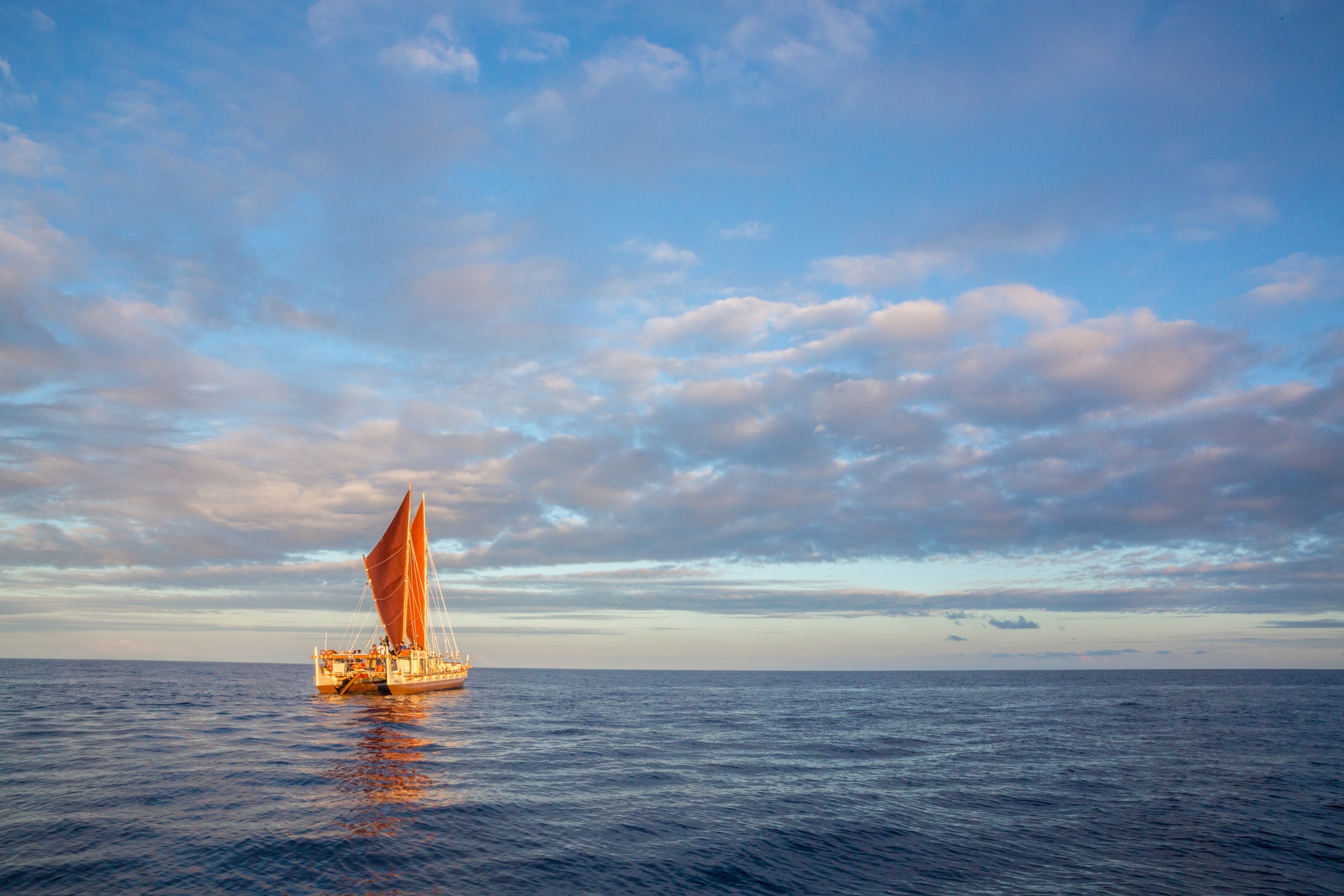
How to follow the Hōkūleʻa
As Hōkūleʻa and Hikianalia journey on the Moananuiākea Voyage, their paths will be tracked on Hokulea.com so anyone can follow along. The website will also post specific port dates throughout the journey.
From Alaska, the canoes sail along the west coasts of North and South America , through Polynesia and north along the West Pacific. Hōkūleʻa will then be shipped from Japan to Los Angeles to sail home to Hawaii. From there, it will voyage to Tahiti in the spring of 2027.
“The ocean will do what it wants,” says Kamalu. “ Hōkūleʻa is an open vessel, so we’re highly exposed and there’s no way to hide from heavy weather. Your skin may be soggy for days.”
( Meet the fearless women taking on the ‘Everest of the Seas.’ )
While the crew will most certainly face challenges along the way, the measure of success isn’t about how much hardship they can take, but what they’re responsible for—making sure that the next generation of wayfinders can take things even farther.
To that end, the Polynesian Voyaging Society has also launched Wa’a Honua , the Canoe for the Earth. The virtual global hub is meant to inspire people to become future navigators for the planet. “This voyage and its impacts reach far beyond the crew that sails,” says Kamalu.
Hōkūleʻa will likely be at sea for the canoe’s 50th anniversary, on May 1, 2026. But there’s no rush to get to a specific destination for that day. “The beauty of voyaging is not to go fast,” says Thompson. “It’s to go slow and take your time. You can’t look up at the stars and tell where you are. In this kind of navigation, you only know where you are by memorizing where you sailed from.”
For Hungry Minds
Related topics.
- CIRCUMNAVIGATION
You May Also Like

Has Amelia Earhart’s plane really been found? 6 key things to know

Visiting Estonia? Here’s what the locals love

10 best things to do in Estonia

10 whimsical ways to experience Scotland

This small strait is essential to global shipping. Now it's the center of headlines.
- Environment
History & Culture
- History & Culture
- History Magazine
- Mind, Body, Wonder
- Coronavirus Coverage
- Paid Content
- Terms of Use
- Privacy Policy
- Your US State Privacy Rights
- Children's Online Privacy Policy
- Interest-Based Ads
- About Nielsen Measurement
- Do Not Sell or Share My Personal Information
- Nat Geo Home
- Attend a Live Event
- Book a Trip
- Inspire Your Kids
- Shop Nat Geo
- Visit the D.C. Museum
- Learn About Our Impact
- Support Our Mission
- Advertise With Us
- Customer Service
- Renew Subscription
- Manage Your Subscription
- Work at Nat Geo
- Sign Up for Our Newsletters
- Contribute to Protect the Planet
Copyright © 1996-2015 National Geographic Society Copyright © 2015-2024 National Geographic Partners, LLC. All rights reserved
Hokulea: A Story of Heroes
By Hawaii.com Team
This artwork by Herb Kane shows the voyaging canoe Hokulea. Photo: Honolulu Star-Advertiser.
On Saturday, June 17, 2017 a dream came true for many thousands of people in Hawaii and around the world. For the very first time, a Polynesian voyaging canoe has circumnavigated the globe. After three years of sailing, the sea vessel Hokulea was welcomed home in Honolulu, Hawaii.
The story of Hawaiian sailing canoes started about 2,000 years ago with voyagers from far distant islands making landfall on the South Point of what we now call Hawaii’s Big Island . The travelers chiseled the tale of their oceanic voyages into the broad surfaces of cooled lava rocks. The stone etchings from hundreds and thousands of years ago leave a clear record of their migration story, even without a written language.
Artist Herb Kane Puts Paint to Canvas and Brings Canoes to Life
Hawaii artist Herb Kawainui Kane had a passion for the South Pacific. He was raised in Waipio Valley on the Big Island. After time in the U.S. Navy, he taught art in Chicago and then came home to South Kona. Canoes depicted in the ancient rock art became a reality as the images of Polynesian voyaging canoes filled his paintings and his life.
In the early 1970s, Kane had an aspiration and wrote “if a voyaging canoe were built and sailed today, it would function as a cultural catalyst and inspire the revival of almost-forgotten aspects of Hawaiian life.” And so, together with a small group of others, Kane founded the Polynesian Voyaging Society. They designed and constructed Hokulea, the first Hawaiian voyaging canoe in hundreds of years. The name Hokulea come to Kane in a dream; it’s the name of a star over Hawaii. In 1975, Hokulea was launched for the first time, and Kane served as the first captain, sailing between the Hawaiian Islands and sharing Hokulea with the people of Hawaii prior to the first open ocean voyage.
Kane did indeed create a cultural catalyst. Hokulea did indeed become the rallying point for the Hawaiian Renaissance of the 1970s, revitalizing Hawaiian language, music, hula and, of course, the ancient art of wayfaring.

The Quiet Hero of the Voyaging World
The captain who moved the art of wayfinding to the top of the international collective knowledge, Nainoa Thompson, is the quiet hero of the voyaging world. He humbly credits Kane as “the father of the Hawaiian Renaissance.” He credits the first crews, and all the voyagers since, for making the dream a reality.
He credits Satawalese Master Navigator Mau Piailug for imparting the knowledge of wayfinding and for making long-distance, non-instrumental ocean navigation possible in Polynesian once again.
Thompson has often spoken of two voyagers that might surprise the hundreds of thousands of fans that follow the Worldwide Voyage. The first is a man named William Anders. In December of 1967, Anders was one of the three crew members, Borman, Lovell and Anders, taking a voyage of discovery. Apollo 8 took off for the moon. Sliding into a smaller spacecraft, Bill Anders orbited the moon, not knowing what was on the dark side or if he would be successful. He was.
Thompson always says of Anders, “I just want to thank him.”
His next hero is Colonel Lacy Veach, a Hawaii boy who decided he wanted to fly into space. And he did. Thompson’s story of his friend’s advice is simple. “We had successful voyages all across the Pacific,” says Thompson. “I wasn’t sure what should come next. I was talking to Lacy [via radio on the canoe in 1992] as he was orbiting over the Hawaiian islands. He said, ‘Do what I am doing; orbit the earth.’”
Over fifteen years later, Thompson has successfully navigated the Hokulea around the earth.
A Worldwide Voyage
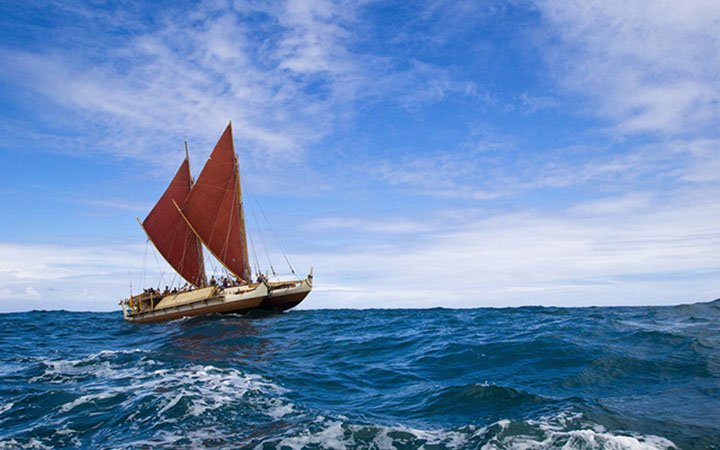
PHOTO COURTESY POLYNESIAN VOYAGING SOCIETY.
When the reports and photos began to roll across the pages of newspapers and magazines people were amazed. The Pamunkey Tribe in Newport News, Virginia never expected to see a voyaging canoe. Friends and relatives drove from Florida and Georgia to see for themselves. They went home to tell their neighbors and relatives about something that, to land-locked mainlanders, seemed like a Disney movie.
Watching the evening news in Hawaii as “our” canoe sailed past the Washington Monument was all the grade school students in Hawaii could talk about. One grade school teacher said she watched it “slowly became real” to her students and pride was “off the charts.”
The facts and figures of the Worldwide Voyage are mind-boggling. 46,000 nautical miles trailed, more than 150 ports visited in over 23 countries and territories. Eight UNESCO World Heritage Marine sites visited. Two hundred and forty-five participating crew members. Over 200 formal and informal educators participated as crew members on the Worldwide Voyage and statewide sail.
The name of the voyage, Malama Honua, means to care for the world. The voyage was as much about caring for our planet as it was about caring for our planet’s people. Thompson speaks of discovering a worldwide culture of “compassion and kindness” that transcends race, geography and political systems.
Could Kane, who passed in 2011, have perceived the impact Hokulea would have on the world? Could the voyagers who first set foot on Hawaii have dreamed their descendants would one day sail the globe?
Hokulea Homecoming – Notes as of June 14, 2017
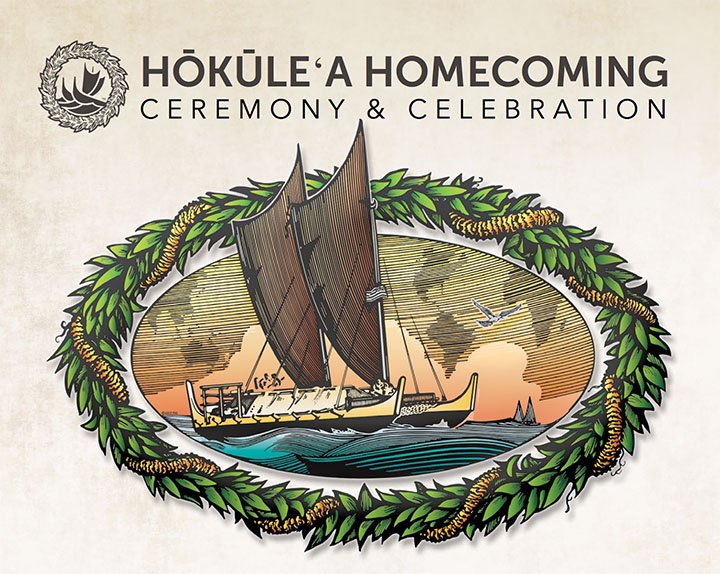
June 17th, 2017 is the day of celebration. Canoes from every island will gather. When Malama Honua began some of the Hawaii islands didn’t have a voyaging canoe or they had one under construction. Now they will gather their fully operational canoes, along with canoes from other Pacific nations, to celebrate. Each carries the message of Malama Honua. As the Ocean Elders have repeated over and over, the need for a clean ocean constantly grows. If we as the protectors of islands and nations do not fight back our children and their children will have no future.
The task will continue. The voyage is not over. For the next year, Hokulea will continue to sail the Hawaiian Islands and continue to inspire new voyagers to wayfind the future.
Read more about Hokulea’s worldwide journey at www.staradvertiser.com/hokulea .
Hawaii Culture & Historic Info
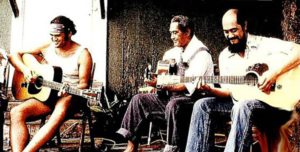
Hawaiian Slack Key Guitar is Honored at the GRAMMY Museum
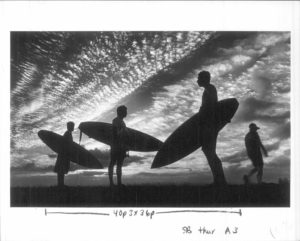
Water World: The History of Surfing
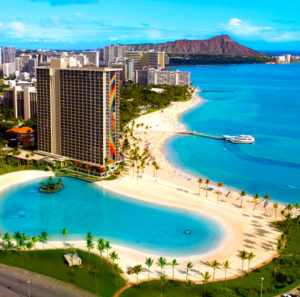
About Hawaii, the Aloha State
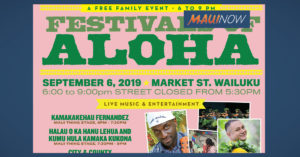
Aloha Festivals Presents “Nā Mele ‘Ukulele”
What's popular.

Road Trip: Drive Around Oahu in a Day

Meet the Majestic Humpback Whale: Hawaii’s Ocean Giants

Visiting Pearl Harbor: Everything You Need To Know

Black Sand Beaches in Hawaii: A Complete Guide
Get hawaii travel deals by email for free.
The National Library of Medicine in partnership with the Ke Ali`i Maka`ainana Hawaiian Civic Club of Washington welcomed the Hōkūleʻa to our nation’s capital May 15-24, 2016.
The Mālama Honua Worldwide Voyage
The Hōkūleʻa, a traditional Polynesian voyaging canoe, arrived in Washington as part of its Mālama Honua Worldwide Voyage.
In Hawaiian, Mālama Honua means “to care for our Earth.” That philosophy underpins the Mālama Honua Worldwide Voyage.
[Nainoa Thompson:] 7,000 years ago the first really Oceanic people came out of China, and came out of Taiwan. Then you get to Polynesia, this Oceanic country bounded by Hawaii in the north and New Zealand in the southwest, and Rapa Nui in the east, 10 million square miles, bigger than Russia, and it was discovered by these extraordinary people. They were really the astronauts of our ancestors. They were the greatest explorers on the face of the earth. [Narrator:] Unaided by modern instruments. These extraordinary explorers discovered and settled every livable land mass in the Pacific, relying solely on a complex understanding of the stars, the winds, the waves, and other cues from nature. ~ Guided by this traditional wisdom and perspective, Hawaiians mastered the science of living sustainably on islands. ~ Western expansion, however, brought not only new ways of seafaring but a shift in perspective on how to interact with the natural environment. ~ Eventually, traditional practices and worldviews were nearly forgotten. But a group of determined individuals got together in the 1970s to resurrect indigenous wisdom by building a traditional canoe and sailing it in the way of the ancestors. ~ Hokulea's first voyage to Tahiti reawakened a cultural pride, identity, and an intimate connection to place. ~ In a generation Hokulea has sailed over 140,000 nautical miles to reunite the world's largest Oceanic nation. ~ Today, Hokulea voyages around the planet with a message of malama honua, or caring for Island Earth, with a firm belief that blending traditional and modern technologies will help us find our way to a healthier future. [Nainoa Thompson: ] Hokulea to us as we go around the world has this enormous potential to go to 40, 50 countries in the planet, to be with the great navigators on Earth, and I'm not talking about those in canoes. I'm talking about those who are doing things to give kindness and compassion to the Earth and those who live on it – those navigators. ~ We're not going to change the world but we're going to go and build a network of people around the earth who are going to change it, and our job is to help them be successful.
The voyage, which began in 2013, is intended to grow the global movement toward a more sustainable world. As the Hōkūleʻa and her sister vessel the Hikianalia sail across Earth’s oceans, their crew and interested followers seek to better understand how indigenous and local wisdom can help us solve some of the greatest global challenges we face.
The Mālama Honua Worldwide Voyage will conclude in 2017, when a new generation of navigators take the helm and guide Hōkūle‘a and Hikianalia back to Polynesia after their journey around the globe.
The National Library of Medicine and the Hōkūleʻa
The NLM’s Native Voices exhibition explores the interconnectedness of wellness, illness, and cultural life for Native Americans, Alaska Natives, and Native Hawaiians. As part of the exhibition, a scale model of the Hōkūleʻa graced the entrance to the Library from 2011-2015, a reminder to all to respect traditions and to look beyond our horizons to learn from others.
The Native Voices Exhibition
The Native Voices exhibition examines concepts of health and wellness among contemporary American Indians, Alaskan Natives and Native Hawaiians. Honoring the native tradition of oral history, the exhibition features personal stories from native people across the country.
Native Voices was on display at the National Library of Medicine in Bethesda from 2011-2015. Through a partnership with the American Library Association, the exhibition is now traveling to 104 sites nationwide through 2020.
Native Hawaiians and the Native Voices Exhibition
200+ interviews with native peoples comprise the core of the exhibition, including 22 testimonials from the Native Hawaiian community. The video above provides excerpts from these 22 testimonials.
The Traveling Exhibition
Through more than 200 interviews and colorful, informative banners, the Native Voices traveling exhibition presents a unique collection of perspectives that both educate and inspire visitors. The video above provides an overview of the traveling exhibition.
The Spirit Lake Dakota Nation welcomed the Native Voices traveling exhibition to Cankdeska Cikana Community College in Fort Totten, North Dakota (October 2013).
The opening of the Native Voices traveling exhibition in Anchorage, Alaska (June 2014) was co-hosted by the Southcentral Foundation, Alaska Native Heritage Center, and National Congress of American Indians.
The traveling exhibition opening at The Queen’s Medical Center in Honolulu, Hawaii coincided with the Center’s 155th Heritage Day celebration honoring its founders (July 2014).
The Chickasaw Nation hosted the Native Voices traveling exhibition at a working art studio and gallery in Sulphur, Oklahoma, where Native artists paint, sculpt, and weave (August 2014).
Native Voices Mobile Apps
Download the official app for the Native Voices exhibition.
Through beautiful streaming video and an interactive art gallery, the exhibition's app explores the interconnectedness of wellness, illness, and cultural life for Native Americans, Alaska Natives, and Native Hawaiians.
Note: the app requires a high-speed Internet connection to enjoy the streaming video.
Traveling Exhibition Schedule
Hawai'i and the voyaging canoe.
Long before Captain Cook and other Europeans set foot in Hawai'i, the natives of Polynesia traveled between island groups in voyaging canoes. The sturdy twin hulls made them particularly well suited to long ocean voyages in uncertain seas and weather.
The ancestors of Native Hawaiians sailed in search of more hospitable and healthier lands to settle, to avoid conflict with rival tribal groups, or to explore the open ocean. Traditional navigators relied on acute powers of observation to set their course by ocean swell patterns, star paths across the sky, the flight of various bird species, and even the smell of the breeze or the taste of seawater.
An Icon of Hawai'ian Culture and Health
Double-hulled voyaging canoes like the Hōkūleʻa were used for millennia by Polynesians for long-distance travel between widely scattered island chains across the vast Pacific Ocean. The Hōkūleʻa was built according to the best understanding of traditional designs and completed its first major voyage, a 5,000-mile round trip between Hawai'i and Tahiti, in 1976. Since then, the Hōkūleʻa has made voyages throughout the Pacific, including trips to Japan, Alaska, and the west coast of the continental United States.
Renaissance of the Hōkūleʻa
The ancient tradition of the voyaging canoe was revived in the 1970s by a group of canoeists and historians. They built a full-scale replica of the double-hulled canoe, based on what designer Herb Kane and others concluded such a canoe would look like. In 1975 they christened the canoe the Hōkūleʻa (the Hawaiian name for the star Arcturus), meaning "Star of Gladness." The team then set out to prove that a double-hulled canoe could make long sea voyages using only sail power, and navigating solely by the stars and subtle clues carried on the wind and waves.
Historian and artist Herb Kane was a founding member of the Polynesian Voyaging Society, the general designer of the Hōkūleʻa, and the captain of its launch. His artwork depicts life and canoeing in ancient Hawaii as well as contemporary Hawaiian culture.
The following audio clips are from an interview Dr. Donald A. B. Lindberg, former director of the National Library of Medicine, conducted with Herb Kane in 2009.
Building the Model
A 1/6-life-size model of the Hōkūleʻa was commissioned by the National Library of Medicine. The model was build by Tay Perry and Jay Dowsett of Honolulu to the general specifications of the 1976 Hōkūleʻa. The model is 10 feet long, compared to the 60-foot-long Hōkūleʻa.
Native Hawai'ian Materials
The Hōkūleʻa model is made entirely from native woods and materials, except for the lashings.
The sails are made from Lauhala, which are leaves of the hala tree (Pandanus tectorius) which have been pounded and woven. Lau means "leaf" in the Hawaiian language.
Listen to model builders Jay Dowsett and Tay Perry talk about the woods used to construct the model.
The Oke Ceremony
Watch the Oke Ceremony that was performed at the delivery of the Hōkūleʻa model to the National Library of Medicine.
The Mālama Honua Worldwide Voyage Continues.
The Hōkūleʻa has completed its visit to Washington, but you can continue following the voyaging canoe at www.hokulea.com . Here you will find schedule updates, local event information, and crew blog stories and photos.
The Mālama Honua Worldwide Voyage is taking Hōkūleʻa 60,000 nautical miles to 100 ports, and 27 nations, to grow a global movement toward a sustainable world.
Hokule'a sets sail on first leg of worldwide voyage

HONOLULU (HawaiiNewsNow) - Hokule'a began the first leg of a worldwide voyage today with a "Malama Hawai'i" statewide sail. There are 22 legs planned for Hokulea's voyage around the world, but the first and final are both right here at home. Crew members say it's about honoring our community and showing Hawaii's people their gratitude.
Over the next four years, Hokule'a and her escort boat and sister canoe, Hikianalia, will travel to 28 countries and stop at 85 international ports – sailing more than 45,000 nautical miles around the world.
"We want to go. It's time to go," said navigator Nainoa Thompson, Hokulea's Captain.
But before they set sail for international waters, Hokule'a and Hikianalia will spend the first five months of their journey right here at home.
"Around Hawai'i sail is the first leg. It's only a thousand miles, probably the shortest of all of them, but it's the most important," described Thompson, before adding this portion of the voyage is crucial to making sure all 250 crew members are trained and prepared before heading to the South Pacific next May.
"In many ways we could go to Tahiti right now. We're safe enough to do that, but I think this engagement with home is a crucial piece to earning that voyage," explained Thompson.
"Malama Honua", or "Care for the Earth", defines the worldwide voyage's mission and crew members say that starts here in the islands with "Malama Hawai'i".
"Home is so important because we have existing relationships. We want to strengthen those and build new relationships and then when we do sail around the world, meeting new people and creating that kind of lei of people that are all trying to do the same thing in our own way - taking care of our larger island earth," explained Ka'iulani Murphy, a navigator and Hokule'a crew member.
Hokule'a and Hikianalia will make 30 stops across the state through October 2013. Each will focus on connecting with the local community through educational outreach.
"Hokule'a is Hawaii's canoe. It was built with that vision in mind in 1976, and she's always been Hawaii's canoe. That's one thing we want everyone to understand that - so when the canoe sails, it's not Hokule'a sailing with a crew. It's all of Hawai'i sailing with Hokule'a," described Bruce Blankenfeld, a navigator and the "Malama Honua" Voyaging Director.
Organizers say the mission of the worldwide voyage is to chart a new course toward sustainable practices for food, energy and our global environment. Crew members say they plan to achieve their goal by sailing around the world, sharing Hawaii's knowledge and skills with others and bringing back what they learn from other countries and cultures along the way.
"The vision is "Malama Honua" -- to care for the Earth, to care for the planet. So the planet is at a point where it's healthy and all people are healthy and everyone is doing well. I think one of the things we want to accomplish is the ability to capture stories and disseminate them and these are stories of human endeavor -- that kind of encompasses that vision of caring for your own home, your rivers, your oceans and things like that. It's going on, it's going on around the world. I think we can learn from each other -- that's for sure -- and the other thing is that we all know that everyone's working together," explained Blankenfeld.
There's no question, the worldwide trip is also about perpetuating the Hawaiian culture and traditional voyaging.
"Now that we have relearned a knowledge that was either sleeping or almost lost – how to navigate across thousands of miles of ocean – it's really about making sure we never lose that again," explained Murphy.
Hokule'a has already sailed 137,000 miles, but crew members say this journey is her biggest undertaking since they landed in Tahiti in 1976 on her maiden voyage.
"When I first started sailing Hokule'a, the idea was just to retrace the migratory paths of our ancestors. Then as years went by we thought about expanding the voyage to include as many islands as possible, but when the idea came up a few years ago – 'Why don't we sail west 'til we reach Hawaii?' Well, why not? I think it's the next step that all of us were ready for," said Billy Richards, who sailed on Hokulea's maiden voyage.
Organizers say the estimated cost for the worldwide voyage is $30 million over the span of four years.
Follow Mileka Lincoln on Facebook: facebook.com/MilekaLincoln.HNN or on Twitter: twitter.com/MilekaLincoln
Copyright 2013 Hawaii News Now . All rights reserved.

Loved ones plead with hit-and-run driver to come forward as mom of 4 remains hospitalized

2 people in stable condition after rollover crash

Man who received $12.5M settlement from HPD arrested for gun crimes

‘We are not hiding’: Company on the defense after being named in carnival fire ant probe

Woman charged for allegedly embezzling over $44,000 in union dues

IMAGES
COMMENTS
Hokulea's first voyage away from Hawaii on May 1, 1976 took her to Tahiti and back—two crews and 52 days at sea.What initially began as a scientific experiment to prove that Polynesians navigated the Pacific, and a nod to the United States bicentennial, ended up being a cultural revitalization in the art of canoe voyaging and navigation.
Hōkūle'a's first voyage to Tahiti in 1976 was a tremendous success. The Tahitians have great traditions and genealogies of ancestral canoes and navigators. ... Crew member Kiki Hugho remembers, "We were hours away from losing people. Hypothermia, exposure, exhaustion. When he paddled away, I really thought he was going to make it and we ...
2003-2004. 2007. The first voyage of the Hokule`a from Hawai`i to Tahiti and back took place in 1976, as part of the Bicentenniel Celebration of American Independence. The official purpose of the voyage was to show that the two-way voyages celebrated in Hawaiian oral traditions could be done in a replica of an ancient voyaging canoe navigated ...
Construction. Polynesian voyaging canoes were made from wood, whereas Hōkūle'a incorporates plywood, fiberglass and resin. Hōkūle'a measures 61 feet 5 inches (18.7 m) LOA, 15 feet 6 inches (4.72 m) at beam, displaces 16,000 pounds (7,260 kg) when empty and can carry another 11,000 pounds (4,990 kg) of gear, supplies and 12 to 16 crew. . Fully laden, with its 540-square-foot (50.2 m 2 ...
Voyages of Rediscovery. Hōkūle'a's first voyage to Tahiti in 1976 was a tremendous success. The Tahitians have great traditions and genealogies of ancestral canoes and navigators. What they didn't have at the time was a voyaging canoe. When Hōkūle'a arrived at the beach in Pape'ete Harbor, over half the island's people were ...
The crew of the Hokule'a knew such a trip was possible; the first Hawaiian settlers did it around the year 1200. Between the first Tahiti voyage and 2007, the Hokule'a made nine more long training voyages around the Pacific area. The longest was to Japan. An escort vessel accompanied each trip for safety.
9. Rapanui. 10. Mau's Legacy. The First Voyage to Tahiti: 1976. Hokule'a's first voyage in 1976 was from Honolua Bay, Maui, to Papeete, Tahiti-a distance of twenty-five hundred miles. Back in the early seventies, before Hokule'a was even built, when they were putting the dream together, they said, "we need to get a Polynesian navigator"-someone ...
Looking back on that day when I witnessed Hokulea's first successful voyage I am reminded that we can all play a part in this important movement to protect our environment. ... For myself, as the oldest crew member (by far) at 72 on this first leg of the WWV, my selection as a crew member is the source of immense personal pride, and my goal ...
Voyaging canoes Hokule'a and Hikianalia sail into Honolua Bay on Saturday to mark 45 years since Hokule'a first departed Honolua Bay for her maiden voyage to Tahiti. The Hokule'a crew ...
The crew were greeted by an estimated 100,000 people after their 40,000-nautical mile voyage. Photograph: Zuma/Alamy Having covered more than 140,000 miles, Hōkūleʻa has inspired other revivals ...
As the first of the fleet of canoes escorting Hōkūle'a enters the channel to Magic Island, many remember when Hōkūle'a first left Honolulu on its first international leg of the World Wide Voyage in May 2014. A crowd in the tens of thousands, growing to an estimated 50,000 by the end of the day, have converged on Magic Island to witness ...
Kahu Kaupu gave the Chrisitan blessing. Hokule`a made its first voyage to and from Tahiti in 1976. The 8-ton Hokule`a can be loaded with about 11,000 pounds, or 5.5 tons, including the weight of a crew of 12-16 people and equipment and supplies. It can make up to 10-12 knots sailing on a reach in strong winds.
Hōkūleʻa is welcomed in Tahiti in 1976. (Polynesian Voyaging Society) The arrival of Hōkūleʻa in Tahiti 1976. More than 17,000 people attended to celebrate this historic landing within the canoe's first long voyage, from Hawai`i to Tahiti and back. Tags: Native people Maritime history Events.
On March 8, 1975, Hōkūle'a, a performance-accurate deep sea voyaging canoe built in the tradition of ancient Hawaiian wa'a kaulua (double-hulled voyaging canoe), was launched from the sacred shores of Hakipu'u-Kualoa, in Kāne'ohe Bay on the island of O'ahu. She was designed by artist and historian Herb Kawainui Kāne, one of the founders of the Polynesian Voyaging Society. The ...
This legendary Polynesian canoe will sail 43,000 miles, from Alaska to Tahiti. The crew of the Hōkūleʻa is embarking on an arduous 47-month journey across the Pacific Rim. In this 2013 photo ...
The name Hokulea come to Kane in a dream; it's the name of a star over Hawaii. In 1975, Hokulea was launched for the first time, and Kane served as the first captain, sailing between the Hawaiian Islands and sharing Hokulea with the people of Hawaii prior to the first open ocean voyage. Kane did indeed create a cultural catalyst.
They're in Juneau to see Hokulea depart on a four-year voyage around the Pacific later this week.For more Local News from Hawaii News Now: https:/www.hawaiin...
A Voyage for Oceans,A Voyage for Earth, 2023 to 2027. Moananuiākea is Hōkūle'a's 15th major voyage in her first 50 years. At the core of Hōkūle'a's creation was exploration - to uncover, recover, and reclaim. Reclaim our culture, traditions, and our relationship to home and our island earth.
#LIVE: Special ceremony for Hokulea is underway as the crew arrive in San Francisco for first time in 28 years as part of 4-year Pacific voyage
Moananuiākea Voyage; Voyage Updates; Crew Members; Updates. Latest Updates; Upcoming Events; Waʻa Honua. Waʻa Honua ... Our latest voyage. Our Vision. Hawai'i, our special island home, is a place where the land and sea are cared for, and people and communities are healthy and safe. ... Hauʻoli La Hanau Hōkūleʻa! 49 years ago today you ...
But a group of determined individuals got together in the 1970s to resurrect indigenous wisdom by building a traditional canoe and sailing it in the way of the ancestors. ~ Hokulea's first voyage to Tahiti reawakened a cultural pride, identity, and an intimate connection to place. ~ In a generation Hokulea has sailed over 140,000 nautical miles ...
Hokule'a has already sailed 137,000 miles, but crew members say this journey is her biggest undertaking since they landed in Tahiti in 1976 on her maiden voyage.